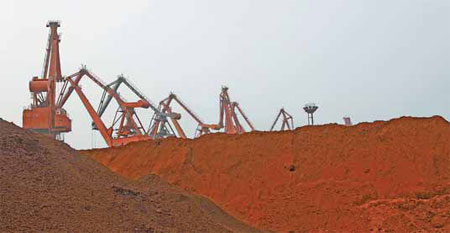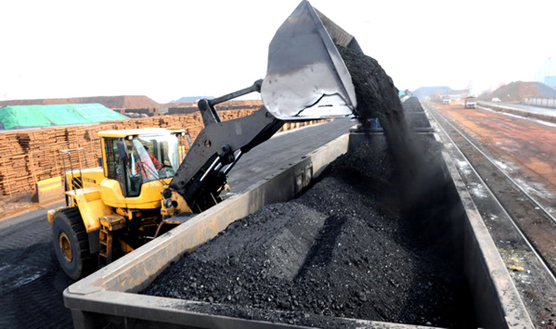Nation eyes Africa mining
Source: www.chinamining.org Citation: Global Times Date: Jun.21, 2012
China`s investments in the African mining sector have increased tenfold since 2011, and the country is pouring more money into the continent while moving away from traditional markets such as Australia due to cost concerns, the China Mining Association said yesterday.
Chinese investment in Africa`s mining sector reached $15.6 billion in 2011, ten times larger than that in the previous year, data released by the trade body yesterday showed.
"The country`s rapid increase of investment in Africa was mainly driven by several large successful projects undertaken by Chinese companies in the continent last year," Yang Qiuling, a spokesperson of the association, told the Global Times yesterday.
Seven such investments in the mining sector in 2011, with even the smallest deal exceeding $1 billion, reached a total of $14.7 billion, accounting for 94 percent of China`s investment in mining in Africa last year, she said.
Meanwhile, China`s mining investment in Australia dropped dramatically to $1.3 billion in 2011, a 70 percent drop from the previous year, figures from the association showed.
In the first half of the year, the country`s total mining investment in Australia was only $140 million, according to the figures.
"The change of Australia`s mining tax policy has made it more expensive to invest in the country," Zheng Jiaxin, chief analyst at Beijing-based ATKEPP International Consulting, told the Global Times.
In March, Australia`s parliament passed laws for a new 30 percent tax on iron ore and coal mine profits.
"Compared to traditional markets such as Australia where it is getting increasingly difficult to get approval, Africa has a lower access threshold," Zheng said.
"Chinese firms now tend to form a consortium to jointly hold shares in mining companies in the emerging mining markets instead of holding controlling stakes as they did in the traditional markets," he noted.
"In this way, it makes it easier to be accepted by the recipient countries and regions such as Africa," he said.
In March, the National Development and Reform Commission approved Aluminum Corporation of China to form a consortium with four other Chinese companies to jointly develop Simandou iron ore mine in Guinea, Africa with Anglo-Australian miner Rio Tinto.
Chalco will hold a 47 percent stake in the joint venture with a total investment of $1.35 billion.
"Transportation issues and labor disputes are big concerns for investment in Africa," Yuan Li, a spokesman with Aluminum Corporation of China, parent of Chalco, told the Global Times yesterday.
"The joint venture makes it easier to share the risks and maximize efficiency," Yuan said.
With China`s growing presence in Africa, labor disputes and threats to Chinese workers` safety are on the rise.
In January, a total of 29 Chinese workers of Sinohydro Group Ltd were taken hostage by rebels in Sudan where the company had a $63 million road project.
About CHINA MINING
Since first held in 1999, the scope and influence of CHINA MINING has grown rapidly year by year. As a global mining summit forum and exhibition, CHINA MINING Congress and Expo has become one of the world’s top mining events, and one of the world’s largest mining exploration, development and trading platforms, covering all aspects of the whole mining industry chain, including geological survey, exploration and development, mining rights trading, mining investment and financing, smelting and processing, mining techniques and equipment, mining services, etc. playing an active promotion role in creating exchange opportunities and enhancing mutual cooperation between domestic and foreign mining enterprises.
CHINA MINING Congress and Expo 2012 will be held at Meijiang Convention and Exhibition Center in Tianjin on November 3-6, 2012. We invite you to join the event and to celebrate the 14th anniversary of CHINA MINING with us. For more information about CHINA MINING 2012, please visit: www.chinaminingtj.org.




 [Photo / China Daily]The Liangyungang Coal Wharf in Jiangsu province. A legislator has called for more policies to encourage greener exploration of coal to improve energy efficiency and reduce pollution.
A legislator has called for more policies to encourage greener exploration of coal in an attempt to improve energy efficiency and reduce pollution.
"Society is now striving to stop extravagance on the dinner table, but what should draw more attention is energy waste," said Bu Changsen, chairman of Shandong Energy Group, the country`s second-largest coal producer.
Bu, also a deputy to the country`s top legislature, said energy waste is extremely severe in the coal production process, which also discharges a large amount of solid waste and dust.
He said coal burning generates 70 percent of the emissions of suspended particulate matter, a major source of air pollution in China.
[Photo / China Daily]The Liangyungang Coal Wharf in Jiangsu province. A legislator has called for more policies to encourage greener exploration of coal to improve energy efficiency and reduce pollution.
A legislator has called for more policies to encourage greener exploration of coal in an attempt to improve energy efficiency and reduce pollution.
"Society is now striving to stop extravagance on the dinner table, but what should draw more attention is energy waste," said Bu Changsen, chairman of Shandong Energy Group, the country`s second-largest coal producer.
Bu, also a deputy to the country`s top legislature, said energy waste is extremely severe in the coal production process, which also discharges a large amount of solid waste and dust.
He said coal burning generates 70 percent of the emissions of suspended particulate matter, a major source of air pollution in China.
